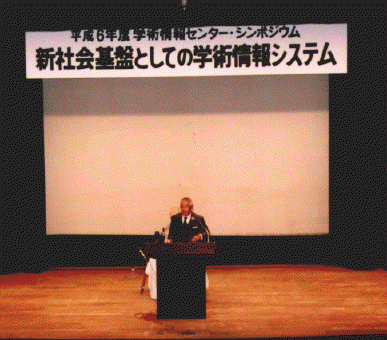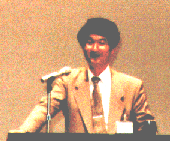1994 NACSIS Symposium

The 1994 NACSIS Symposium was recently held in both Osaka and Tokyo, under
the banner of: "Science Information Systems as a New Social
Infrastructure." The Osaka site of the symposium was held at the Oval Hall
on October 13 (Thursday) and was attended by 122 people, while the Tokyo
site was held at the Maison Franco-Japonaise (Nichifutsu Kaikan Hall) on
November 16 (Wednesday) and was attended by 459 people.
The symposium was opened under the chairmanship of Professor Hitoshi INOUE,
Director of the Research and Development Department of NACSIS, who gave the
opening address as representative of the sponsors at the Osaka site.
Professor Hiroshi INOSE, Director General of NACSIS, gave the opening
address at the Tokyo site. The program was as follows:
- Information Communications Networks as a New Social Infrastructure
- Dr. Kunihiro KATO, Executive Manager of the Engineering Planning
Department, NTT's Research and Development Headquarters
- Enhancement of SINET
- Tokyo: Dr. Shoichiro ASANO, Professor, NACSIS
- Osaka: Dr. Hisao UOSE, Associate Professor (Visiting), NACSIS
- Trial Service of the Electronic Library
- Dr. Jun ADACHI, Professor, NACSIS
- The Future of Information Retrieval Systems
- Dr. Teruo KOYAMA, Professor, NACSIS
- Plans for the Next Generation of Cataloging System
- Akira MIYAZAWA, Professor, NACSIS
Brief outlines of each of these presentations are introduced below.
---------------------------------------------------------------------

Dr. Kunihiro KATO, Executive Manager of the Engineering Planning
Department, NTT's Research and Development Headquarters
1. Introduction
There is a continuing move toward multimedia within the field of
information communications networks, against a background of advances such
as the fusion of telecommunications, broadcasting, and computing based
mainly on the use of telephone lines. In this brief summary, I would like
to introduce some trends relating to information communications networks,
trends in multimedia services, and the configuration of an infrastructure
that will support such multimedia services.
2. Trends in Information Communications Networks
Information communications networks are developing in two directions: as
public telecommunications networks progressing from telephone works, to
digital data exchange works (DDX), and then to asynchronous transfer mode
(ATM) works, and as computer communications networks progressing from
personal-computer local area networks (LANs), to inter-LAN links consisting
of routers and dedicated lines, and then onto the Internet. This section of
the symposium considers the developmental status of each of these types of
information communications network from the viewpoint of their disposition,
including details such as the positioning of the Science Information
Network, and also discusses the significance of new multimedia
communications networks that combine both public telecommunications
networks and computer communications networks.
3. Trends in Multimedia Services
This section discusses our awareness at NTT of the services provided by
NACSIS, directives concerning speeds and fee systems aimed at future
multimedia services, and examples of possible services of the future.
4. Construction of Infrastructure Network
Some of the features of multimedia information that are cited are its high
speed, its wide bandwidth, and its bursty operation. It has become
necessary to construct a high speed, broad-bandwidth backbone network ATM
and ultra-high speed optical transmission) as an infrastructure for
handling such information efficiently, as well as to speed up the
corresponding access nets (by suitable optical or satellite means). A
suitable high speed, broad-bandwidth backbone network is already under
construction, so this part of the symposium discusses trends concerning
problems that will be encountered in speeding up the access nets.
5. Conclusion
While everyone in the terminal, information provider, and
telecommunications fields is working towards the true dawn of the
multimedia age, we at NTT recognize that NACSIS is in an important position
within this territory to administer a comprehensive network (system)
linking together all three of these fields. We expect them to contribute
immensely in the raising of multimedia applications in the future.
----------------------------------------------------------------------
 Tokyo: Dr. Shoichiro ASANO, Professor, NACSIS
Tokyo: Dr. Shoichiro ASANO, Professor, NACSIS
 Osaka: Dr. Hisao UOSE, Associate Professor (Visiting), NACSIS
Osaka: Dr. Hisao UOSE, Associate Professor (Visiting), NACSIS
The National Center for Science Information Systems (NACSIS) has been
operating the Science Information Network since 1986, providing general
networking services for academic research purposes. In the first phase of
network services, the NACSIS has installed 29 packet switching systems at
29 locations covering Japan from Hokkaido to Okinawa Island. At the second
stage beginning from 1992, the NACSIS has begun the Internet Backbone
service which is called SINET. 29 TCP/IP routers are also installed at the
same locations interconnecting these routers with high speed digital
circuit of 6Mbps or lMbps. Current SINET circuits are configured based on
two layered hierarchical topology where the ring topology interconnecting
among 10 nucleus nodes including NACSIS, on the other hand, other nodes are
connected to nearest nucleus node with star topology. The Asynchronous
Transfer Mode (ATM) equipment and Frame Relay equipment are newly installed
at each node in 1994 in order to realize flexible and high performance
communication control in the SINET.
It might be international trends that ATM based enhancement is adopted to
research networks. Currently, ATM is most promising scheme to achieve high
performance communication capability when used in such environment where no
bottlenecks raised by communication interferences between high speed
application occur. However, real situation in research network is not so
simple. Such examples as actual limitation of bandwidth of circuits
employed in research networks, realistic bounds of efficiency in
multiplexing of applications, inconsistency of communication control
between LAN and WAN, as well as mismatch of throughput between LAN and WAN,
are the factors of hamper in introduction of simplified ATM operation.
In practice, it is significant that adaptations and developments of network
technologies to meet with real environment is necessary to implement high
performance SINET. Introduction of new equipment is merely the first step
of SINET enhancement, and, by conducting developments and feasibility
demonstrations, we will realize more sophisticated SINET in a couple of
years.
---------------------------------------------------------------------
 Dr. Jun ADACHI, Professor, NACSIS
Dr. Jun ADACHI, Professor, NACSIS
Aims of NACSIS Electronic Library System
Over the past few years, the Research and Development Department of NACSIS
has developed an electronic library system that is provisionally called
NACSIS-ELS. The project overview will be outlined briefly, based on the
present system which has already reached the trial service stage.
The system is designed to provide a primary information service for
scientific materials derived from journals and conference proceedings, and
it works on a high-speed wide-area network, such as the internet. Since
this service encompasses conventional document delivery services,
NACSIS-ELS is expected to supply a model for a comprehensive scientific
information service in the near future.
Sample System Operations
Two typical retrieval scenarios could be considered when you try to get a
document. The first is to look for materials through secondary information.
This is a usual approach employed in conventional online information
retrieval using boolean search of key words. The second could be to reach
documents directly on your workstation from journal's cover page icons,
just like you try to pick up a journal from book selves.
System Design Considerations
This system employs typical techniques used on the internet; it
incorporates a client-server system configuration, secures
network-transparency by the use of IP protocol, and is composed of
page-image databases as well as conventional secondary information
databases. Implementing a more user-friendly interface is one of the
crucial design criteria.
Concluding remarks
NACSIS' most important roles in the coming high-speed network age would be
to provide the basic facility for networking as well as stable storage
functions. Thus, making the most of the relationship with university
libraries and academic societies, we regard it as our responsibility to
develop new services, rapidly responding to new technological trends. The
trial service of NACSIS-ELS is the first step towards that direction.
---------------------------------------------------------------------
 Plans for the Next Generation of Cataloging System
Plans for the Next Generation of Cataloging System
 Akira MIYAZAWA, Professor, NACSIS
Akira MIYAZAWA, Professor, NACSIS
In December of this year, it was exactly ten years since the NACSIS-CAT
system started trial operation. There have been huge changes in the
hardware and software environments for information systems during that
time. From the hardware viewpoint, so-called "down-sizing" has occurred to
produce smaller, faster systems; from the software viewpoint, the tide of
new advances such as open system architectures, client-server systems, and
graphics user interfaces (GUIs) has made these features commonplace.
Library systems that are users of NACSIS-CAT and NACSIS-ILL have always
been conservative as business systems, but as the 90s dawned, they found
they could no longer ignore the new trends. This meant that we found it
inevitable that NACSIS-CAT and NACSIS-ILL would have to change to suit the
new hardware and software environments.
Therefore, NACSIS has started planning of next generation cataloging
system. The first step will be introduction of a new database server
system, and new client system for new user interface will follow it.
However, the essential functions of CAT system, involving the creation and
maintenance of union catalogs, and the ILL system that reflects such usage
and applies for loans, will not change their basic nature even if a new
system is introduced. Changes to adapt to the new environment and
improvements based on experience in operations up to now will form new
system functions that are currently under review.
In other words, the development of new services and the use of our union
catalogs within new services are essential changes.
That is why we consider it is preferable that the new CAT system itself
does not become multifunctional and obese, but should rather simply
concentrate on its role of creating and maintaining union catalogs.


 Tokyo: Dr. Shoichiro ASANO, Professor, NACSIS
Tokyo: Dr. Shoichiro ASANO, Professor, NACSIS Osaka: Dr. Hisao UOSE, Associate Professor (Visiting), NACSIS
Osaka: Dr. Hisao UOSE, Associate Professor (Visiting), NACSIS Dr. Jun ADACHI, Professor, NACSIS
Dr. Jun ADACHI, Professor, NACSIS Plans for the Next Generation of Cataloging System
Plans for the Next Generation of Cataloging System
 Akira MIYAZAWA, Professor, NACSIS
Akira MIYAZAWA, Professor, NACSIS